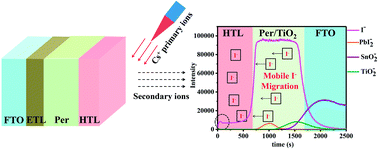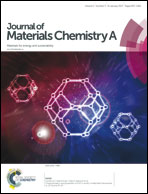Profiling the organic cation-dependent degradation of organolead halide perovskite solar cells†
Abstract
Operational stability is one of the main obstacles that may hold back the commercialization of perovskite solar cells (PVSCs). In this paper, we provide a detailed account of the ion migration accelerated PVSC degradation by comparatively studying perovskite materials with two different organic cations (methylammonium (MA+) and formamidinium (FA+)). Using time of flight secondary ion mass spectrometry (TOF-SIMS), we have uncovered the ion migration accelerated degradation of PVSCs at the device level. Not only did mobile iodide (I−) ions from the perovskite layer diffuse out, but Ag atoms/ions from the metal electrode also diffused into the perovskite layer, which resulted in severe device degradation. Besides, we identified I− species in the hole transport material (HTM) layer for even freshly prepared PVSC devices, which was responsible for the degradation of devices kept under inert conditions. This also testifies the existence of ion migration on the device level of PVSCs. Compared with MAPbI3, the ion migration process can slow down in FAPbI3 devices which accounts for a better stability of FAPbI3 devices. This work underscores the impact of organic cation substitution on PVSC degradation and provides solid evidence for mobile ion migration in perovskite materials and the consequent degradation in specific device settings such as the n–i–p type perovskite solar cells.


 Please wait while we load your content...
Please wait while we load your content...